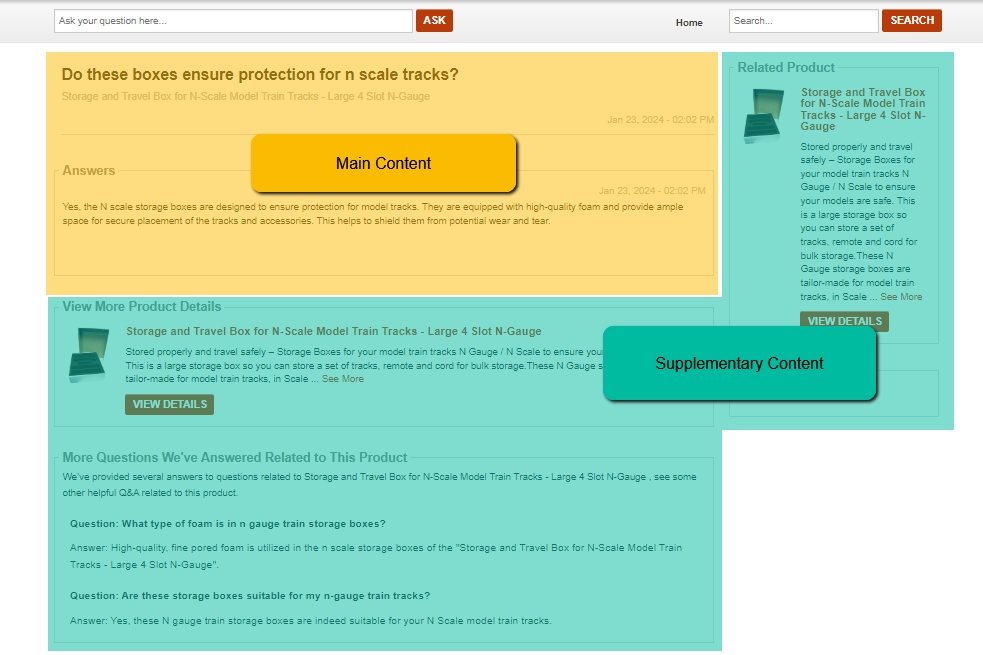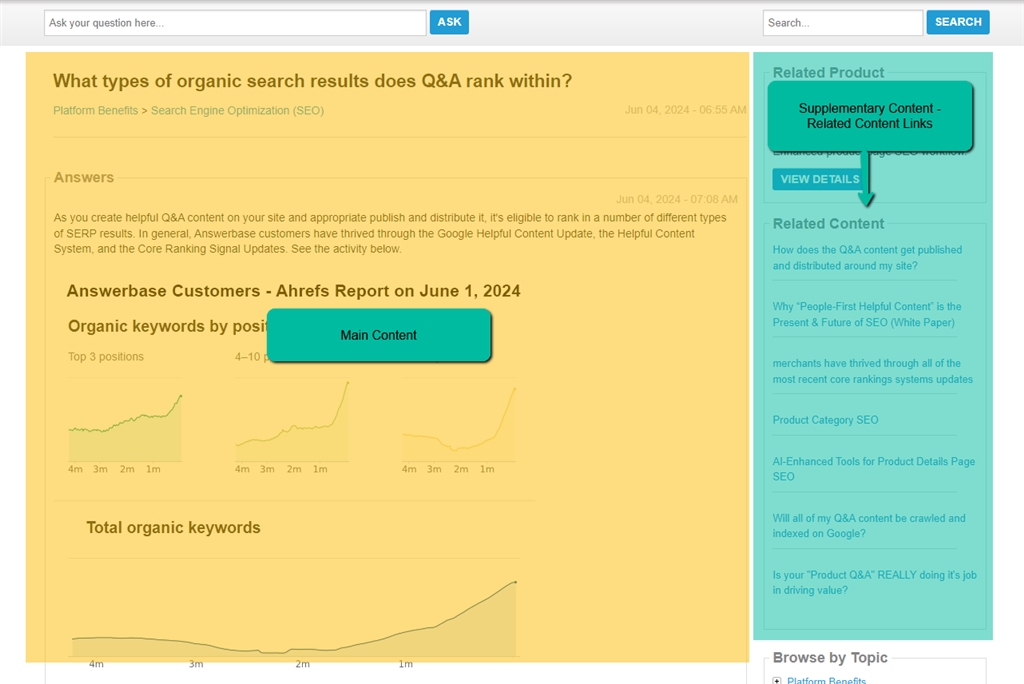Answer
Jun 11, 2024 - 03:53 PM
When Google looks at a page, it breaks the page down a bit to identify what the "Main Content" is, the "Supplementary Content" and then the "Advertisements/Monetization" of the page. See how Google defines each of these here:
"Supplementary Content (SC) is an important part of the user experience. One common type of SC is navigation links that allow users to visit other parts of the website. In some cases, content behind tabs may be considered part of the SC. Sometimes the easiest way to identify SC is to look for the parts of the page that are not MC or Ads. "
Answerbase enables merchants to intelligently automate what Q&A content should be considered "Main Content" and what content can/should be used as "Supplementary Content". You'll see that we have settings to achieve this under "System Settings > SEO > Supplementary Content".
For example, if some Q&A combinations don't have enough search volume on Google to warrant their own Q&A landing page, it's still valuable and useful content but it doesn't deserve a page dedicated to it. In these cases, Answerbase can designate that as "Supplementary Content" and then when a customer is asking a question via search....they can be lead to the appropriate Q&A landing page that resolves their main reason for being there....but then the other "Supplementary Content" Q&A that is relevant to that specific product...is still useful information and social proof...and you can show them that.
So, how that breaks down for a Q&A landing page would be as seen here:

As with any content, it's about ensuring that the visitor is having a great experience with "people-first helpful content". So, your priority when they get to the page is to ensure that the question that they have is answered. That is why the section in yellow is laser-focused on the question and the answer.
Then, after they're done reading the Q&A pair and the intent of the search is satisfied....they can start to read a bit about the product that the Q&A pair is associated with and click in to see the product details page if they'd like. It also shows off the "Supplementary Content" Q&A which is other Q&A pairs that is also related to that product....so it's relevant and valuable to this visitor, it's just not the main reason they got to the page in the first place so it's considered Supplementary Content instead of the Main Content of the page.
Note that the product connection, information, and call to action is kind of a hybrid between "Supplementary Content" and "Ad". We consider it supplementary content because it is really the context and "parent" of the Q&A pair, so information about the product also helps supplement the main purpose of the page...it's not just a way to make money on the content, it also provides helpful information to the visitor that is directly related to their main purpose of the page. That's the great thing about product associated Q&A, because the content is so closely related to the sale....it has the benefits of an advertisement but leaning much more towards providing helpful content and information as opposed to "selling". This is why we see 7.5% of engagements with the Q&A content leading to a conversion, it's the perfect combination of servicing the customer so low in the marketing funnel that they're primed for purchase.
Answerbase also supports other types of "Supplementary Content" like "Related Content" links which you can associate to specific Q&A pairs...they show up on the right side of the Q&A content...similar to this example:

Again, you should only be referring to other content and pages that are actually helpful to the visitor and they'll have the best possible experience with the page. Google's Helpful Content System (which is now part of their core ranking systems) was focused on one thing.....in Google's words it was this:
"reward content where visitors feel they've had a satisfying experience"
So, all of the content on your pages should be focused on that "satisfactory experience", and if you ensure that both your main content and supplementary content is relevant and helpful to the visitor (categorized and and published appropriately based on search demand), your content should be rewarded and perform well.
- Main Content (MC): Main Content is any part of the page that directly helps the page achieve its purpose.
- Supplementary Content (SC): Supplementary Content contributes to a good user experience on the page, but does not directly help the page achieve its purpose.
- Advertisements/Monetization (Ads) . Advertisements/Monetization (Ads) is content and/or links that are displayed for the purpose of monetizing (making money from) the page.
"Supplementary Content (SC) is an important part of the user experience. One common type of SC is navigation links that allow users to visit other parts of the website. In some cases, content behind tabs may be considered part of the SC. Sometimes the easiest way to identify SC is to look for the parts of the page that are not MC or Ads. "
Answerbase enables merchants to intelligently automate what Q&A content should be considered "Main Content" and what content can/should be used as "Supplementary Content". You'll see that we have settings to achieve this under "System Settings > SEO > Supplementary Content".
For example, if some Q&A combinations don't have enough search volume on Google to warrant their own Q&A landing page, it's still valuable and useful content but it doesn't deserve a page dedicated to it. In these cases, Answerbase can designate that as "Supplementary Content" and then when a customer is asking a question via search....they can be lead to the appropriate Q&A landing page that resolves their main reason for being there....but then the other "Supplementary Content" Q&A that is relevant to that specific product...is still useful information and social proof...and you can show them that.
So, how that breaks down for a Q&A landing page would be as seen here:

As with any content, it's about ensuring that the visitor is having a great experience with "people-first helpful content". So, your priority when they get to the page is to ensure that the question that they have is answered. That is why the section in yellow is laser-focused on the question and the answer.
Then, after they're done reading the Q&A pair and the intent of the search is satisfied....they can start to read a bit about the product that the Q&A pair is associated with and click in to see the product details page if they'd like. It also shows off the "Supplementary Content" Q&A which is other Q&A pairs that is also related to that product....so it's relevant and valuable to this visitor, it's just not the main reason they got to the page in the first place so it's considered Supplementary Content instead of the Main Content of the page.
Note that the product connection, information, and call to action is kind of a hybrid between "Supplementary Content" and "Ad". We consider it supplementary content because it is really the context and "parent" of the Q&A pair, so information about the product also helps supplement the main purpose of the page...it's not just a way to make money on the content, it also provides helpful information to the visitor that is directly related to their main purpose of the page. That's the great thing about product associated Q&A, because the content is so closely related to the sale....it has the benefits of an advertisement but leaning much more towards providing helpful content and information as opposed to "selling". This is why we see 7.5% of engagements with the Q&A content leading to a conversion, it's the perfect combination of servicing the customer so low in the marketing funnel that they're primed for purchase.
Answerbase also supports other types of "Supplementary Content" like "Related Content" links which you can associate to specific Q&A pairs...they show up on the right side of the Q&A content...similar to this example:

Again, you should only be referring to other content and pages that are actually helpful to the visitor and they'll have the best possible experience with the page. Google's Helpful Content System (which is now part of their core ranking systems) was focused on one thing.....in Google's words it was this:
"reward content where visitors feel they've had a satisfying experience"
So, all of the content on your pages should be focused on that "satisfactory experience", and if you ensure that both your main content and supplementary content is relevant and helpful to the visitor (categorized and and published appropriately based on search demand), your content should be rewarded and perform well.

